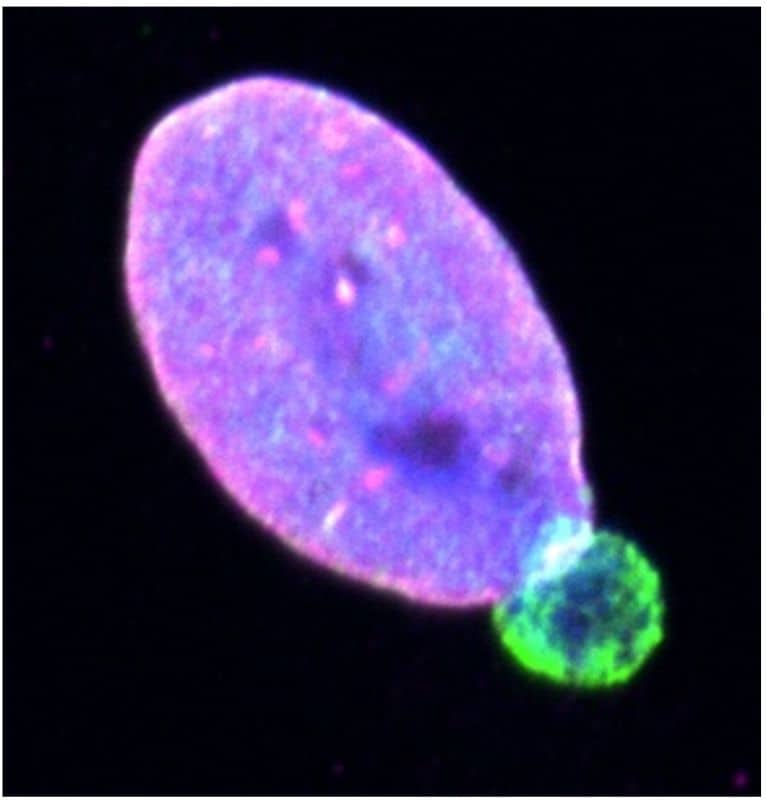A new study carried out by the Queen Mary University of London, King’s College London, and the Francis Crick Institute has discovered a protein that increases the aggressiveness of melanoma, the most dangerous form of skin cancer, by enabling cancer cells to alter the shape of their nuclei, a property that allows the cells to move around the body and metastasize.
The research, which was just published in Nature Cell Biology, modeled the behavior of melanoma cells that are aggressive and have the capacity to alter the structure of their nucleus in order to get around physical obstacles that prevent cancer cells from migrating freely across tissues. According to the research, elevated amounts of a protein called LAP1 were detected in these aggressive melanoma cells, and these levels were associated with a poor prognosis in melanoma patients.
Melanoma is a kind of skin cancer that has the potential to spread to the body’s internal organs. Cancer spread, often known as “metastasis,” is the major cause of cancer mortality. The processes by which metastasis develops are poorly known, despite the fact that it has been widely investigated. The study’s results provide new insight into the process of melanoma advancement and may open the door to the development of new methods to stop the disease’s growth.
The research
In laboratory trials, the researchers challenged aggressive and less aggressive melanoma cells to travel through gaps in an artificial membrane smaller than the size of their nuclei. The less aggressive cells came from the patient’s initial or “primary” melanoma tumor, whereas the more aggressive cells came from a location of metastasis in the same patient.
To spread, cancer cells must break away from the main tumor, move to another part of the body, and start growing there. However, cancer cells find it physically challenging to do this because of the crowded environment of a tumor.
The nucleus, a big, hard structure within each cell that houses the genetic material for that particular cell, also limits the capacity of that cell to move through the small spaces seen in the environment of tumors. Cancer cells must make their nucleus more pliable in order to fit through these openings.

Imaging done following the migration trials revealed that the aggressive cells formed ‘blebs’ at the edge of their nuclei, which allowed them to migrate through the pores more efficiently than the less aggressive ones. The aggressive melanoma cells that produced the blebs had increased quantities of the LAP1 protein, which is found in the membrane around the nucleus (called the nuclear envelope), according to genetic analysis of the melanoma cells.
“The nuclear envelope is tethered to the underlying nucleus, and our investigations show that the LAP1 protein loosens this tethering, allowing the nuclear envelope to bulge away and form blebs that make the nucleus more fluid. As a result, the cancer cells could squeeze through gaps that would normally stop them,” explains Dr. Jeremy Carlton.
When the scientists inhibited the synthesis of the LAP1 protein in aggressive cells and then re-challenged them to migrate through holes, they discovered that the cells were less able to generate nuclear envelope blebs and less able to squeeze through these pores.

The same pattern of LAP1 expression was also seen in samples from people with melanoma. In melanoma patients, LAP1 levels in metastatic tissue samples were greater than those in main tumor tissue samples. High levels of LAP1 in the cells around the main tumor were associated with more aggressive malignancy and worse outcomes, indicating that this protein might be utilized to identify subpopulations of melanoma patients who may be at increased risk of aggressive illness.
According to Professor Sanz-Moreno, the results of new study show “that LAP1 is a key regulator of melanoma aggressiveness in laboratory and patient models.”
Since LAP1 is expressed at such high levels in metastatic cells, disruption of this molecular mechanism may have significant effects on the progression of cancer. In the future, the authors want to look at methods to target LAP1 and nuclear envelope blebbing to determine whether it is feasible to prevent this mechanism of melanoma advancement because there are presently no medications that directly target LAP1.
To assess whether nuclear envelope blebbing triggered by LAP1 aids or inhibits cancer growth, the team wants to study other cells in a tumor’s surroundings, such as immune cells.
“This new understanding of how the nucleus of a melanoma cell can become more fluid to move around the body,” according to Dr. Iain Foulkes, “is useful for building our knowledge of how cancer works and opens up a new avenue of investigation into ways to make it harder for cancer to spread.”
Cancer Research UK, the Wellcome Trust, and Barts Charity provided the majority of the funding for the project, which was co-led by Professor Victoria Sanz-Moreno of Queen Mary’s Barts Cancer Institute and Dr. Jeremy Carlton of King’s College London and The Francis Crick Institute.
Source: 10.1038/s41556-022-01042-3
Image Credit: Shutterstock
